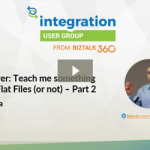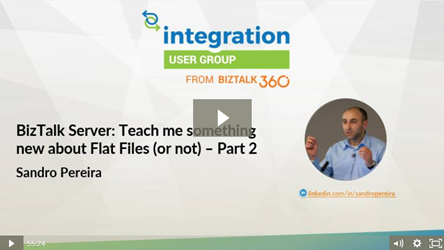This post was originally published here
Last year I presented several sessions on Integration Monday community but I never had the chance, for several and different reasons, to proper highlight on my personal blog. The second session that I delivered last year was the second part of the topic BizTalk Server: Teach me something new about Flat Files (or not) Part II.
In that session I tried to address and solve the following questions:
- How to suppress Empty Lines everywhere (end or middle)?
- My positional flat-file contains data that does not match the length expected (and they are not filled with empty spaces). How can I handle that?
- What if we don’t want to remove Headers but… in fact we want to deal with Headers and Trailers?
- Do I need to always create a custom pipeline for dealing with Flat-Files? Or it is possible to create a Generic Pipeline?
That was the sixth session that I deliver for that community:
About my session
Session Name: BizTalk Server: Teach me something new about Flat Files (or not) Part II
Session Overview: This is the second part of Sandro Pereira’s earlier presentation on flat files on Integration Monday. You can watch the video recording of the previous session here.
Despite over the year’s new protocols, formats or patterns emerged like Web Services, WCF RESTful services, XML, JSON, among others. The use of text files (Flat Files) as CSV (Comma Separated Values) or TXT, one of the oldest common patterns for exchanging messages, still remains today one of the most used standards in systems integration and/or communication with business partners.
While tools like Excel can help us interpret such files, this type of process is always iterative and requires few user tips so that software can determine where there is a need to separate the fields/columns as well the data type of each field. But for a system integration (Enterprise Application Integration) like BizTalk Server, you must reduce any ambiguity, so that these kinds of operations can be performed thousands of times with confidence and without having recourse to a manual operator.
You can see the recording session here: BizTalk Server: Teach me something new about Flat Files (or not) Part II.
About Integration Monday
Integration Monday is full of great sessions that you can watch and I will also take this opportunity to invite you all to join us next Monday.

